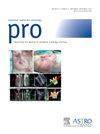Patient Positional Uncertainty and Margin Reduction in Lung Stereotactic Ablative Radiation Therapy Using Pneumatic Abdominal Compression
IF 3.5
3区 医学
Q2 ONCOLOGY
引用次数: 0
Abstract
Purpose
Motion management presents a significant challenge in thoracic stereotactic ablative radiation therapy (SABR). Currently, a 5.0-mm standard planning target volume (PTV) margin is widely used to ensure adequate dose to the tumor. Considering recent advancements in tumor localization and motion management, there is merit to reassessing the necessary PTV margins for modern techniques. This work presents a large-scale analysis of intrafraction repositioning for lung SABR under forced shallow breathing to determine the margin requirements for modern delivery techniques.
Methods and Materials
Treatment data for 124 lung SABR patients treated in 607 fractions on a linear accelerator were retrospectively collected for analysis. All patients were treated using pneumatic abdominal compression and intrafraction 4-dimensional (4D) cone beam computed tomography (4D CBCT)-guided repositioning halfway through treatment. Executed repositioning shifts were collected and used to calculate margin requirements using the 2-SD method and an analytical model which accounts for systematic and random errors in treatment.
Results
A total of 85.7% of treated fractions had 3-dimensional repositioning shifts under 5.0 mm. Fifty-three fractions (8.7%) had shifts ≥ 5.0 mm in at least 1 direction. Margins in the right-left, inferior-superior, and posterior-anterior directions were 3.62 mm, 4.34 mm, and 3.50 mm, respectively, calculated using the 2-SD method. The analytical approach estimated that 4.01 mm, 4.37 mm, and 3.95 mm margins were appropriate for our workflow. Executing intrafraction repositioning reduced margin requirements by 0.73 ± 0.07 mm.
Conclusions
Clinical data suggest that the uniform 5.0-mm margin is conservative for our workflow. Using modern techniques such as 4D CT, 4D CBCT, and effective motion management can significantly reduce required margins, and therefore necessary healthy tissue dose. However, the limitations of margin calculation models must be considered, and margin reduction must be approached with caution. Users should conduct a formal risk assessment prior to adopting new standard PTV margins.
腹部压迫肺立体定向消融放疗中患者位置不确定。
目的:运动管理是胸部立体定向消融放疗(SABR)的一个重大挑战。目前,5.0 mm的标准规划靶体积(PTV)边缘被广泛用于确保足够的肿瘤剂量。考虑到肿瘤定位和运动管理的最新进展,重新评估现代技术所需的PTV边缘是有价值的。这项工作提出了在强制浅呼吸下肺SABR的抽吸内重新定位的大规模分析,以确定现代交付技术的边际要求。方法与材料:回顾性收集124例肺SABR患者在直线加速器上607次治疗的治疗资料进行分析。所有患者均在治疗中途采用腹部充气压缩和4D锥形束计算机断层扫描(4D CBCT)引导下重新定位。收集已执行的重新定位位移,并使用2标准偏差(2SD)方法和解释处理中的系统和随机误差的分析模型来计算保证金需求。结果:85.7%的治疗部位出现5.0 mm以下的三维重定位移位,53个部位(8.7%)至少有一个方向移位≥5.0 mm。采用2SD法计算,左右、上下、前后方向的边缘分别为3.62 mm、4.34 mm、3.50 mm。分析方法估计4.01 mm、4.37 mm和3.95 mm的裕度适合我们的工作流程。结论:临床数据表明,在我们的工作流程中,均匀的5.0 mm切缘是保守的。利用现代技术,如4D CT、4D CBCT和有效的运动管理可以显著减少所需的边缘,从而减少必要的健康组织剂量。然而,必须考虑到保证金计算模型的局限性,并且必须谨慎对待保证金减少。用户应在采用新的标准PTV边际之前进行正式的风险评估。
本文章由计算机程序翻译,如有差异,请以英文原文为准。
求助全文
约1分钟内获得全文
求助全文
来源期刊

Practical Radiation Oncology
Medicine-Radiology, Nuclear Medicine and Imaging
CiteScore
5.20
自引率
6.10%
发文量
177
审稿时长
34 days
期刊介绍:
The overarching mission of Practical Radiation Oncology is to improve the quality of radiation oncology practice. PRO''s purpose is to document the state of current practice, providing background for those in training and continuing education for practitioners, through discussion and illustration of new techniques, evaluation of current practices, and publication of case reports. PRO strives to provide its readers content that emphasizes knowledge "with a purpose." The content of PRO includes:
Original articles focusing on patient safety, quality measurement, or quality improvement initiatives
Original articles focusing on imaging, contouring, target delineation, simulation, treatment planning, immobilization, organ motion, and other practical issues
ASTRO guidelines, position papers, and consensus statements
Essays that highlight enriching personal experiences in caring for cancer patients and their families.
 求助内容:
求助内容: 应助结果提醒方式:
应助结果提醒方式:


